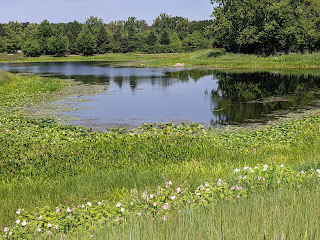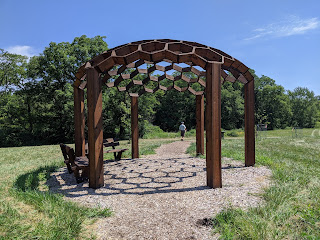Steven and I were blessed to be first time grandparents in late May last year when our granddaughter, Max, was born in San Francisco to our son and daughter-in-law. That was why we'd headed out to see the happy family at the beginning of the month-long Western states road trip that ended in early July. Just seven weeks after Max arrived, our second granddaughter, Clara, was born in Chicago even though our daughter and son-in-law weren't expecting her for another three weeks! We were so delighted to head out again on another road trip so we could spend a few days with Clara and her parents.

Steven and I saw the I Am a Man mural in our daughter's Chicago neighborhood of Wicker Park. I didn't realize how significant and famous the mural was at the time, nor that it honored an iconic moment in Black history. I just learned that it was a recreation of a famous photo taken the day before Dr. Martin Luther King Jr. was assassinated in Memphis in 1968. The I Am a Man sign was carried by striking sanitation workers King had come to Memphis to assist. It is now a popular sign at civil rights protests.
After getting lots of hugs and kisses in with our newest month-old angel, we headed to the Chicago suburb of Lisle to visit Morton Arboretum, the 1,700 acre park that was home to 4,300 types of trees, shrubs, and other plants.
As the oldest continuously maintained hedge display in the US, the Arboretum's Hedge Collection included 64 living 'fences' made of shrubs or trees.
Since the Arboretum's tree collection was still young in 1934, the collection has provided a destination for visitors. It was neat to discover that six species from the Hedge Collection had been incorporated into the Arboretum's Maze Garden in 2003 because of knowledge learned from decades of hedge management.
We then decided to stroll over to the Conifer Walk where we were reminded that conifers meant cone bearing and their leaves were needle-like, awl-shaped or scale-like. I hadn't realized, however, that conifers were one of the most threatened plants on earth. Of the 125 conifers in The Morton Arboretum's collection, 13 were in danger of extinction in the wild.
Would you have guessed that there were anywhere near 600 species of conifers in the world plus many cultivated species called cultivars? I didn't have a clue that there were that many!
The conifers on the Walk that were globally threatened in the wild were due to climate change, habitat destruction, overharvesting, pests, and diseases.
I read that arboretums (technically arboreta by the way!) help conserve threatened species by keeping examples in off-site collections like Morton's. Seeds are acquired in the wild where they are threatened and then the trees are grown in a protected location. That way they can provide genetic material in the future if the remaining wild trees are lost.
How sad to learn that the majestic pau brasil tree only found in Brazil was in danger of becoming extinct because for hundreds of years makers of violas, violins, and cellos have relied on the tree to make the instruments' bows. Now only about five percent of the pau brasil forests remain.
One of the best selling cancer drugs comes from the scrawny Pacific yew tree. In the 1960s, compounds from trees began to be tested for their cancer-fighting abilities. Of the 15,000 plants that were chosen by scientists for initial testing, just 5 made it to advanced testing. One plant - the Pacific yew - made it to pharmacies.
Demand for the Pacific yew became so fierce it threatened the tree's wild population. Discovering medications takes extensive work. How scary to think that if a tree becomes extinct, its medical secrets also disappear.
Meadow Lake:
Rocky Bardur was our first glimpse of one of the characters in the Arboretum's Troll Hunt! After seeing it, we couldn't wait to find the other five colossal trolls crafted from reclaimed wood by Danish artist Thomas Dambo. The 15-30-foot tall sculptures were commissioned to serve as protectors of our environment.
Here was Sneaky Socks Alexa!
We had to hike to the far reaches of the Arboretum and then up a steep hill to get a close up of Joe the Guardian overlooking the highway. It was well worth the exercise, though!
The Arboretum included a large collection of crabapple trees.
What an idyllic spot to admire the crabapples!
Almost one hundred years ago, staff at the Arboretum planted a linden tree collection on the park's east side. Though many lindens were still growing there, there wasn't much room left for newly acquired specimens. I could understand how managing the Arboretum's 1,700 acres required careful planning and lots of foresight as moving older trees was very tough.
You've been warned - troll ahead!
This was Furry Ema!
The Arboretum's Bur Reed Marsh was characterized as a wetlands treasure because it wasn't manmade like most of the park's wetlands. Thousands of years ago, a glacier carved out this small basin and covered the landscape with dense clay. Rainwater collects in the basin as the clay slows the water from seeping downward. Over time, these marsh plants have taken hold.
We next followed the trail into the Arboretum's East Woods to explore its 'natural area.' While other parts of the Arboretum had organized plant collections, this woodland was here when the first Euro-American people arrived.
The first to manage the landscape were the Native Americans who lived in villages. Later, European settlers transformed prairies and wetlands into farmland. They used woodlands as sources of fuel and timber. At the beginning of the 20th century, landowners sold the land that was now the East Woods to the Arboretum. Initially, staff allowed trees and grasses to regrow. Conservationists have recently taken active steps to restore the landscape.
This was no normal big rock at the Arboretum! Big Rock weighed an estimated 12-14 tons with apparently about fifteen percent underground. It was probably deposited by a glacier receding at the end of the last ice age. With the glacier possibly being as tall as a 30-story building, Big Rock would have been a tiny pebble by comparison.
Unfortunately, I can't remember the name of this troll. My bad as one of our sons would say!
Little Arturs was not so little; he was actually 60 feet long! I thought the Troll Hunt was an exceedingly clever way to make us all think more seriously about how to take care of and appreciate trees.
Things to remember:
As the Arboretum was an international leader in tree conservation, they connected scientists, environmentalists, and nature advocates from around the world to protect trees and their habitats. The Arboretum wasn't just a place to view beautiful trees - it was a 1,700-acre living laboratory!
Next post: A heat-shortened trip to the Chicago Zoo.
Posted on January 17th, 2021, on the eve of our last day here in Phoenix, Arizona. We'll be heading home to far colder temperatures but have already made plans to return to Phoenix for a full month next winter as this has been a wonderful escape from even Denver's generally mild winters. As always, I hope and pray you stay safe, healthy, and connected with family and friends as we face the horrific pandemic together.











































No comments:
Post a Comment